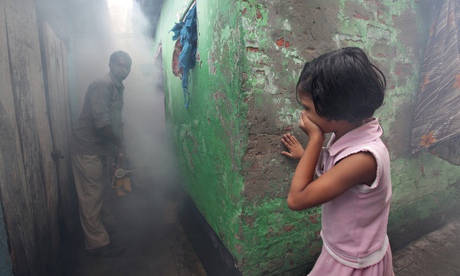
The annual number of dengue fever cases in India is nearly 300 times higher than officially reported, according to a study by US and Indian researchers.
The report also finds the sometimes fatal viral disease, which is transmitted by mosquitoes, costs the emerging economic power at least $1.1bn (£700m) each year in medical and other expenses.
“We found that India had nearly 6m annual clinically diagnosed dengue cases between 2006 and 2012 – almost 300 times greater than the number of cases that had been officially reported,” said Prof Donald S Shepard, health economics professor at Brandeis University, Massachusetts, who led the five-year research project.
The scale of the under-reporting surprised researchers and will raise concerns that India’s response to the disease is inadequate, causing unnecessary suffering locally and undermining global attempts to restrict the spread of the virus.
“With most infectious diseases the public healthy community has been succeeding. Ebola is an exception but hopefully a short-term one. My hope for the next decade is that we turn the tide with dengue,” said Shepard, who has been working on dengue since the early 1990s.
In the last 50 years the incidence of dengue worldwide has increased 30-fold, largely as a consequence of the growth of cities and increased travel. The virus causes severe joint pain and fever lasting up to several weeks and can kill.
An eight-year-old became the first confirmed fatal casualty of the disease in Delhi this year at the weekend.
Inhabitants of sprawling Indian cities have long suspected that official figures did not reflect the spread of the disease.
An estimated 2.5 billion people live in countries where dengue has become established. Ten years ago the World Health Organisation estimated that 50m infections occurred annually, causing 22,000 deaths, mainly among children. The total is believed to be much higher today.
India is believed to have more cases of dengue than any other country in the world, and except for a slight dip in 2011 its incidence rate has grown steadily in recent years. A major dengue outbreak in 2013, with more than 55,000 reported cases, was triggered largely by heavy rains. Standing water is a breeding ground for mosquitoes.
In 2013 India’s national vector borne diseases control programme reported that the country had experienced an annual average of 20,474 dengue cases and 132 dengue-related deaths since 2007.
Shepard said various factors had contributed to the low official reporting, ranging from busy doctors not finding the time to fill in paperwork through to the difficulty of accurate diagnosis. Many people were treated in private hospitals, which rarely report cases of dengue to the authorities.
“Many countries consider it an embarrassment … that it is a failure of the public health system. In India the reporting is based on lab confirmed cases; many other places use suspect cases,” he said.
Other nations also under-reported incidence of dengue but by lower margins of between 10 and 30 times.
The five-year study was funded by Sanofi-Pasteur, the major pharmaceutical company developing a vaccine against dengue, and approved by the Indian government. It is to be published in the American Journal of Tropical Medicine & Hygiene.
According to the WHO, dengue caused infrequent and sporadic epidemics through the 19th century but surged from the 1950s.
Though still largely restricted to the developing world, there are increasing numbers of cases in Europe and the US.
In 2013 there were 541 cases reported in the UK in people returning from dengue-affected countries with the disease, compared with 343 in 2012. Most cases were reported in travellers returning from India and Thailand.
Some experts have warned climate change could make European holiday destinations vulnerable to dengue outbreaks by making parts of Italy and Spain hotter and more humid. Pockets of dengue have also been found in the US.
Earlier this week municipal authorities in the Indian capital, Delhi, said they were considering a payment worth £5,000 to families of anyone who died of the disease. More than 5,500 dengue cases and six deaths were registered in the city last year.
Indian officials say they are aware that the government statistics may not reflect the true extent of the problem but say including suspected cases would only increase the total by a multiple of five or “at most 10”.
